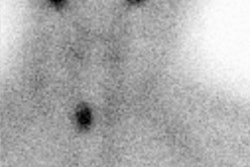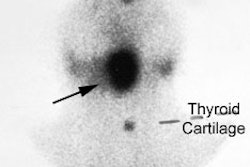J Nucl Med 1994 Sep;35(9):1418-22
Testicular function in patients with differentiated thyroid carcinoma treated
with radioiodine.
Pacini F, Gasperi M, Fugazzola L, Ceccarelli C, Lippi F, Centoni R, Martino E,
Pinchera A.
The aim of the present study was to assess whether 131I therapy for
differentiated thyroid carcinoma (DTC) can affect endocrine testicular function.
METHODS: Serum follicle-stimulating hormone (FSH) and testosterone (T)
concentrations were measured in 103 patients periodically submitted for
radioiodine therapy for residual or metastatic disease. Mean follow-up was 93.7
+/- 54 mo (range 10-243 mo). RESULTS: Mean FSH values in 131I-treated patients
tested after their last treatment were 15.3 +/- 9.9 mU/ml, significantly higher
than those of 19 untreated patients (6.5 +/- 3.1 mU/ml). Considering the mean +3
s.d. FSH of untreated subjects as the upper limit of normal range, 36.8% of the
patients had an abnormal increase in serum FSH. Longitudinal analysis performed
in 21 patients showed that the behavior of FSH in response to 131I therapy was
not universal. Six patients had no change or a slight increase in serum FSH
after 131I administration; eleven patients had a transient increase above normal
values 6-12 mo after 131I treatment, with return to normal levels in subsequent
months. The administration of a second dose was followed by a similar increase
in FSH levels. Finally, four patients, followed for a long period of time and
treated with several 131I doses, showed a progressive increase in serum FSH,
which eventually became permanent. Semen analysis, performed in a small subgroup
of patients, showed a consistent reduction in the number of normokinetic sperm.
No change was found in serum T levels between treated and untreated patients.
CONCLUSIONS: Our results indicate that 131I therapy for thyroid carcinoma is
associated with transient impairment of testicular germinal cell function. The
damage may become permanent for high-radiation activities delivered year after
year and might pose a significant risk of infertility.




